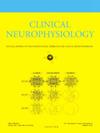Calcium-dependent nonlinearity describes the after-effects of different patterns of theta-burst TMS
IF 3.6
3区 医学
Q1 CLINICAL NEUROLOGY
引用次数: 0
Abstract
Objective
Optimisation of transcranial magnetic stimulation protocol parameters can potentially improve their efficacy through theoretical mathematical models. This study aims to develop an elaborate but still parsimonious quantitative model for understanding the dosage-dependency of Theta-Burst Stimulation (TBS).
Methods
We propose a calcium-dependent nonlinear model that uses Michaelis–Menten kinetics to represent competing molecular pathways in postsynaptic neurons during TBS intervention. The model integrates four subsystems: calcium dynamics, modulation substances, MEP learning, and metaplasticity, with a particular focus on the interaction between facilitatory and inhibitory signalling cascades.
Results
Our model successfully reproduces experimental findings from various TBS protocols, including the reversal of after-effects observed in prolonged stimulation. The simulation results suggest that the competing molecular pathways with distinct calcium sensitivities and temporal dynamics determine the direction of after-effects.
Conclusions
This proposed model represents a substantial advancement in understanding TBS-induced neuromodulation by providing testable predictions for untested TBS protocols and offers complementary insights into the underlying neural mechanisms.
Significance
This model offers a basic framework for potentially incorporating complex, nonlinear relationships between TBS parameters and after-effects under various neurological and psychiatric conditions. It also provides a valuable tool for later protocol optimisation and guiding future experimental designs.
钙依赖性非线性描述了不同模式的脉冲经颅磁刺激的后效。
目的:通过理论数学模型优化经颅磁刺激方案参数,提高经颅磁刺激的疗效。本研究旨在建立一个详尽但仍然简洁的定量模型,以理解脉冲刺激(TBS)的剂量依赖性。方法:我们提出了一个钙依赖的非线性模型,该模型使用Michaelis-Menten动力学来表示TBS干预期间突触后神经元中相互竞争的分子通路。该模型集成了四个子系统:钙动力学、调节物质、MEP学习和元塑性,特别关注促进和抑制信号级联之间的相互作用。结果:我们的模型成功地再现了各种TBS方案的实验结果,包括在长时间刺激中观察到的后效逆转。模拟结果表明,具有不同钙敏感性和时间动力学的相互竞争的分子途径决定了后效的方向。结论:该模型为未经测试的TBS方案提供了可测试的预测,在理解TBS诱导的神经调节方面取得了实质性进展,并为潜在的神经机制提供了补充见解。意义:该模型提供了一个基本框架,可以潜在地纳入各种神经和精神疾病下TBS参数与后遗症之间复杂的非线性关系。它也为以后的协议优化和指导未来的实验设计提供了有价值的工具。
本文章由计算机程序翻译,如有差异,请以英文原文为准。
求助全文
约1分钟内获得全文
求助全文
来源期刊

Clinical Neurophysiology
医学-临床神经学
CiteScore
8.70
自引率
6.40%
发文量
932
审稿时长
59 days
期刊介绍:
As of January 1999, The journal Electroencephalography and Clinical Neurophysiology, and its two sections Electromyography and Motor Control and Evoked Potentials have amalgamated to become this journal - Clinical Neurophysiology.
Clinical Neurophysiology is the official journal of the International Federation of Clinical Neurophysiology, the Brazilian Society of Clinical Neurophysiology, the Czech Society of Clinical Neurophysiology, the Italian Clinical Neurophysiology Society and the International Society of Intraoperative Neurophysiology.The journal is dedicated to fostering research and disseminating information on all aspects of both normal and abnormal functioning of the nervous system. The key aim of the publication is to disseminate scholarly reports on the pathophysiology underlying diseases of the central and peripheral nervous system of human patients. Clinical trials that use neurophysiological measures to document change are encouraged, as are manuscripts reporting data on integrated neuroimaging of central nervous function including, but not limited to, functional MRI, MEG, EEG, PET and other neuroimaging modalities.
 求助内容:
求助内容: 应助结果提醒方式:
应助结果提醒方式:


